Diesel Locomotive Works
The Diesel Locomotive Works (DLW) in Varanasi, India, is a production unit of Indian Railways. DLW stopped manufacturing Diesel locomotives in March 2019 as IR is moving towards 100% electrification of its rail network. Currently DLW produces only electric locomotives WAP-7(Passenger) & WAG-9HC(Freight). It was the largest diesel-electric locomotive manufacturer in India.
| Indian Railways production unit | |
| Industry | Diesel Locomotive Electric locomotive |
| Founded | 1961 |
| Founder | Indian Railways |
| Headquarters | , |
Area served | India & South East Asian Countries |
Key people | YashPal Singh (General Manager), [1] |
| Owner | Indian Railways |
| Website | www |
Company
Founded in 1961, the DLW rolled out its first locomotive three years later, on 3 January 1964. It manufactures locomotives which are variants based on the original ALCO designs dating to 1960s and the GM EMD designs of the 1990s.[2] DLW has an annual production capacity of 250 locomotives[3] and plans to increase it to 275 based on the current demand.[4][5] Since inception, DLW has manufactured a total of 8099 various types of locomotives(figures as of 31 January 2018). DLW manufactured 334 diesel-electric locomotives during financial year 2016–17, which is the highest ever loco production by any loco manufacturing unit in India and bagged the "Best Production Unit Shield" for the second successive year.
In AUGUST 2019, DLW developed the India's first bi-mode locomotive, the WDAP-5.
Locomotives produced at DLW
DLW locomotives have power outputs ranging from 2,600 horsepower (1,900 kW) to 5,500 horsepower (4,100 kW). Currently DLW is producing WAP 7 and WAG 9 for Indian Railways. Some of its EMD locomotive products are WDP-4D, WDG-4D, WDG-5 and others as of June 2015.DLW Stopped Production of WDG4D and WDP4D in March 2019.DLW recently started producing HEP capable WAP-7 high horsepower Electric Locomotives and its series starting from 37*** and WDM-2G genset locomotives. Recently, it has been allotted to Santragachi & Tughlakabad Loco Shed.
The designation of the locomotives follows the Nomenclature of Indian Railways. Prototypes and individual vehicles are not listed.
| Model series | Number | Construction year | Development | Commitment | Engine | Axis formula | Picture |
|---|---|---|---|---|---|---|---|
| WDM-2 | 2700 | 1962–1998 | Technological Transfer
Alco DL560C |
Mixed Traffic locomotive | Alco 251B
12-cylinder 2600 HP |
Co′Co′ | 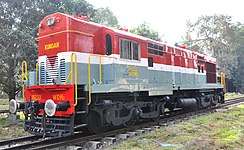 |
| WDM-3A | 158 new
700 rebulit |
1994–1998 | WDM-2
with upgraded engine |
Mixed Traffic locomotive | Alco 251C
16-Cylinder 3100 HP |
Co′Co′ | 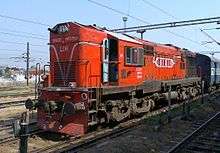 |
| WDM-3D | 344 | 2003 | WDM-3A
with Microprocessor engine control EMD parts and bloster-less bogies |
Mixed Traffic locomotive | Alco 251C
16-Cylinder 3300 HP |
Co′Co′ | 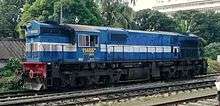 |
| WDM-7 | 15 | 1987–1989 | lowered power version of WDM-2 | Shunting service,Branch lines Mixed Traffic locomotive | Alco 251B
12-Cylinder 2600 HP |
Co′Co′ |  |
| WDP-1 | 69 | 1995–1999 | WDM-2-Variant for passenger traffic | Passenger traffic | Alco 251C
12-Cylinder 2300 HP |
Bo′Bo′ | _locomotive_with_Rewari_Passenger.jpg) |
| WDP-3A | 69 | 1998–2002 | variant developed from WDM-3A for passenger trains with two final driver's cabs and max speed of 160 km / hr | Passenger traffic | Alco 251C
16-Cylinder 3100 HP |
Co′Co′ | 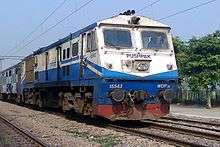 |
| WDP-4 | 102 | 2002–2011 | Technology Transfer
EMD GT46PAC |
Passenger traffic | EMD 710G3B
16-Cylinder 4000 HP |
Bo1′1Bo′ |  |
| WDP-4B | 90 | 2010–2014 | The WDG4 derived passenger locomotive | Passenger Traffic | EMD 710G3B
16-Cylinder 4500 HP |
Co′Co′ | 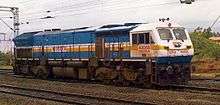 |
| WDP-4D | 234 | 2010–2019 | WDP-4B with dual cabs | Passenger Traffic | EMD 710G3B
16-Cylinder 4500 HP |
Co′Co′ |  |
| WDG-3A | 1998 | 1995–2010 | freight variant of WDM-3A | Goods traffic | Alco 251C
16-Cylinder 3100 HP |
Co′Co′ | 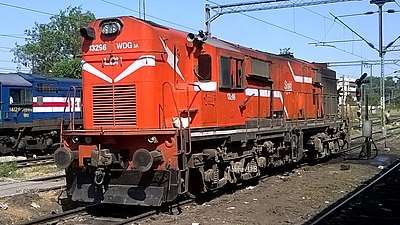 |
| WDG-4 | 431 | 1999–2012 | Technology Transfer
EMD GT46MAC |
Goods traffic | EMD 710G3B
16-Cylinder 4000 HP |
Co′Co′ | |
| WDG-4D | 240 | 2013–2019 | WDG-4D | Goods traffic | EMD 710G3B
16-Cylinder 4500 HP |
Co′Co′ | 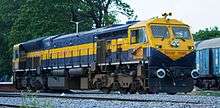 |
| WDS-6 | 270 | 1975– | Drivetrain of the YDM-4 meter gauge locomotive as part of the WDM-2 Body | Shunting | Alco 251D
6-Cylinder 1400 HP |
Co′Co′ | 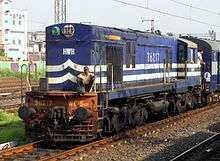 |
| YDM-4 | 541 | 1961–1993 | Technology transfer
Alco DL535A |
Metre gauge | Alco 251D
6-Cylinder 1400 HP |
Co′Co′ |
Market
Besides the Indian Railways, it regularly exports diesel-electric locomotives[5] and has supplied locomotives to other countries such as Sri Lanka, Nepal, Bangladesh, Mali, Senegal,[6] Sudan[7] Tanzania, Angola, and Vietnam and also to a few users within India, such as ports, large power and steel plants and private railways.[8][9]
Ancillary
In July 2006, DLW outsourced manufacture of some passenger and freight locomotives to Parel Workshop, Central Railway, Mumbai.[10]
See also
- Diesel Locomotive Factory, Marhowra
- Electric Locomotive Factory, Madhepura
- Chittaranjan Locomotive Works, Asansol
- Integral Coach Factory, Chennai
- Modern Coach Factory, Raebareli
- Rail Coach Factory, Kapurthala
- Rail Wheel Plant, Bela
- Rail Wheel Factory, Yelehanka
- Titagarh Wagons, Titagarh
- List of locomotive builders by countries
References
- http://www.newindianexpress.com/pti-news/2017/oct/30/govt-appoints-five-new-general-managers-in-railways-1687308.html
- "Diesel Locomotive Works (DLW)". Retrieved 11 January 2008.
- "DLW meets annual target ahead of the deadline". The Indian express Group. 17 March 2008. Archived from the original on 23 August 2009.
- "Rlys plan to make more locomotives to tap global mkt". The Financial Express. 8 August 2008.
- "DLW sets new record in locomotive production". Times of India. 1 January 2012. Retrieved 14 January 2012.
- "Indian Railways exports four diesel locomotives". The Economic Times. 15 January 2008.
- "Rs. 80-crore target for railway spares export". The Hindu. Chennai, India. 11 November 2004.
- "Retiring DLW GM flags off rail engine". Times of India. 30 June 2009. Retrieved 14 January 2012.
- "IR to soon manufacture high power locomotives". Times of India. 9 October 2010. Retrieved 14 January 2012.
- Verma, Kalpana (19 August 2008). "Engine manufacturing unit at Parel a boon for Rlys". Indian Express. Archived from the original on 22 January 2013. Retrieved 14 January 2012.
External links
| Wikimedia Commons has media related to Diesel locomotives of India. |